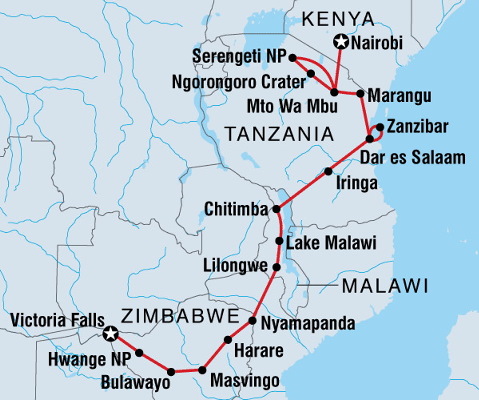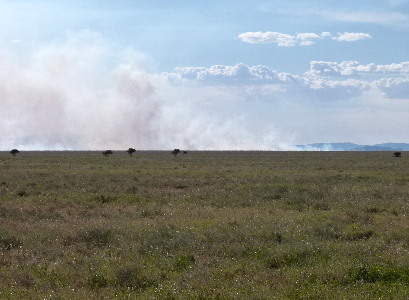
Traveling south from Kenya into Tanzania we started to see Masai in their traditional blankets.
We stopped for lunch in the "shade" of this tree.
While we were there a youngster came along with a herd of goats and soon we were joined by several others.
We offered the three youngest sandwiches the older siblings(?),couple(?) hung back.
The rainy season hadn't yet begun so there were dust devils and the goats didn't have much to graze on.
Markets on the outskirts of a larger town and Arusha's impressive fire department.
A cowrolla. Not an uncommon sight.
Next stop the Ngorongoro crater.
Views of the from two overlooks.


The crater is now one of Tanzania's National Parks but it has always been an area rich in wildlife with streams and a large lake.
Some of the wildlife we saw there.
Thomson's gazelle
Wildebeest and their young.
Savanna Buffalo
While we were in Africa we saw several species of zebra. These were Grant's Zebras.
It can be a bit of trouble to get down to a stream.
Or across it.
More zebras down by the lake.
We spotted Spotted Hyenas (sorry).
They all look scruffy but we all thought that the little ones were cute.
Hartebeest and Grant's Gazelle
Flamingos, gulls, and zebras.
White Rhinoceros, I think. It doesn't matter if they are called white or black they are all gray.
Elephants with warthogs, a lion, and buffalo
Warthogs
Ostriches
Lions and two Crowned Cranes.
And Hippopotamuses
A Green Vervet monkey
And just after we left the crater saw a Masai giraffe browsing on an Acacia tree.
Then more as we got closer to the Serengeti National Park.
Park entrance.
Its name is taken from the Masai words for never ending plains.
Near the entrance it was very dry when we were there in mid February.
There were several grass fires in the distance.

Occasional rock outcrops provide a vantage point for photographs.
As we got deeper into the park we started to see some greenery and wildlife.
These are Thomson's gazelles
A sausage tree.
I don't know how our guide could spot leopards in a tree while driving along.
Yes, I know leopards are always spotted. (Sorry, I promise it won't happen again)
There is one in this tree. Do the second and third shots help?
Another one that is easier to find.
One in a sausage tree
Not often you find them on the ground in the middle of the day posing for you.
Hippos
Camp that evening.
We hadn't seen lions during the day but we heard them overnight.
A gorgeous sunrise as we were getting ready for our next adventure.
An antelope herd by a umbrella Acacia tree and a Masai giraffe browsing on another.
Giraffe look so stately as the wander across the plains.
Hyrax lived in the rock outcrops.
Believe it or not their closest genetic relatives are elephants and seacows.
We stationed ourselves at a watering hole where we saw some zebras, wildebeest, and just upstream hippos.
Then we saw the Great Migration coming.
There is no way for my description to do it justice.
It was like being inside a National Geographic TV Special.
As they came up they would mill around, then some would come to get water, abruptly bolt off, and another group would come in.
Then things got really interesting as this lady came loping in with a determined look.
She was the first of a pride of 27 lions.
As she approached we saw that she was using our Land Rover for cover to get closer to the herd.


She suddenly sprang into a full run as you can see in this video.
A longer version showing the Great Migration, the pride advancing, and the attack is here.
The lions start their approach at about 2:52 and a missed attack at 3:15, the kill at 3:38, the rest of the pride approaching at 4:07, and seven coming in to feed at 5:35.
A few of the ones that got away.
The aftermath.
Most of the rest of the pride came past us with only seven breaking off to feed on the zebra.
Our guide told us that they were all offspring of the female that made the kill.
Later we saw this female wearing a tracking collar with her two cubs.
We drove on and saw even more of the migration.
This video isn't the best but it will give you some idea of how many animals we saw from just one location.
Of course there were all the animals we had seen previously.
Mongooses not Mongeese, Right?
Adult and one pup.
A family of them in camp.
Just to get you oriented as to where we are now.
The yellow central area is the Serengeti National Park.
The white and yellow areas together are the Serengeti ecosystem, about 25000 square km (6100 square miles)
The larger area is protected by five Game Reserves, the Lollondo Game Controlled area, and the Ngorongoro Conservation area.
They are represented in green where they extend beyond the actual Serengeti ecosystem.
Some wildlife is easy to overlook.
Camp. The cooking shelter has heavy mesh to keep marauding animals from taking our food.
We, on the other hand, are protected by ... sturdy canvas.
The next day we continued to cross the apparently never ending grasslands.
Hartebeest
Jackals
Hyrax in it's favorite niche, both ecological and physical.
These rock outcrops are called koppes, pronounced "copies".
Long necks let you see predators further away so they have an adaptive value even here where there isn't much tall vegetation to browse on.
Elephants hang together for protection of the herd.
More Ostriches
This leopard was spotted as we drove along. (Yes, I know I promised not to pun again, so sue me.)
A large crocodile and a hippo shared a pond.
A very pregnant lioness dozing in a tree.
I hope she is able to get down before dropping her cubs.
I can't explain what limits the fire here.
Grassland as dry as this is would be burned entirely black where we live in Kentucky.
Sunset? Sunrise? We were as likely to see on as the other.
Two of our group took a hot air balloon ride to see the plains from the air.
A couple of lizards on the rocks.
A tiny Dikdik antelope beside the road.
Two Masai walking across the plain miles from anything.
Most of the roads weren't great but occasionally there was something like this.
Goats and herdsmen.
As we left the plains we passed the Ngorongoro for one last look from the rim.

It is hard for us to believe we really were there.
Looking down we saw buffalo grazing.
We had to price some tanzanite when we were in Tanzania after all.
We couldn't even afford the raw uncut untreated stones.
A Savanna Monitor
We went back past the rescue and fire department in Arusha.
A town near there is called Mto Wa Mbu (river of mosquitoes).
A city big enough to have a traffic jam.
This one happened to be due to the failure of the hydraulic clutch on a 16 ton truck named Claudia.
How do we know these details?
It has been our home for this whole trip so we know her well.
A lot of supervisors from our group were overseeing the job.
A wood shop specializing in beds.
And a market.
People on the way to town.
Mount Kilimanjaro appeared from behind the clouds.
The truck had yet another breakdown.
This one next to a field of sisal.
Some of us figured out how to strip fibers out of the leaves and twist and braid them into a string.
We got caught in a traffic jam in Dar es Salaam. It is the largest city in Tanzania.
We finally got to camp, had a good night, and a beautiful sunrise.
In the morning we were on our way to Zanzibar.
